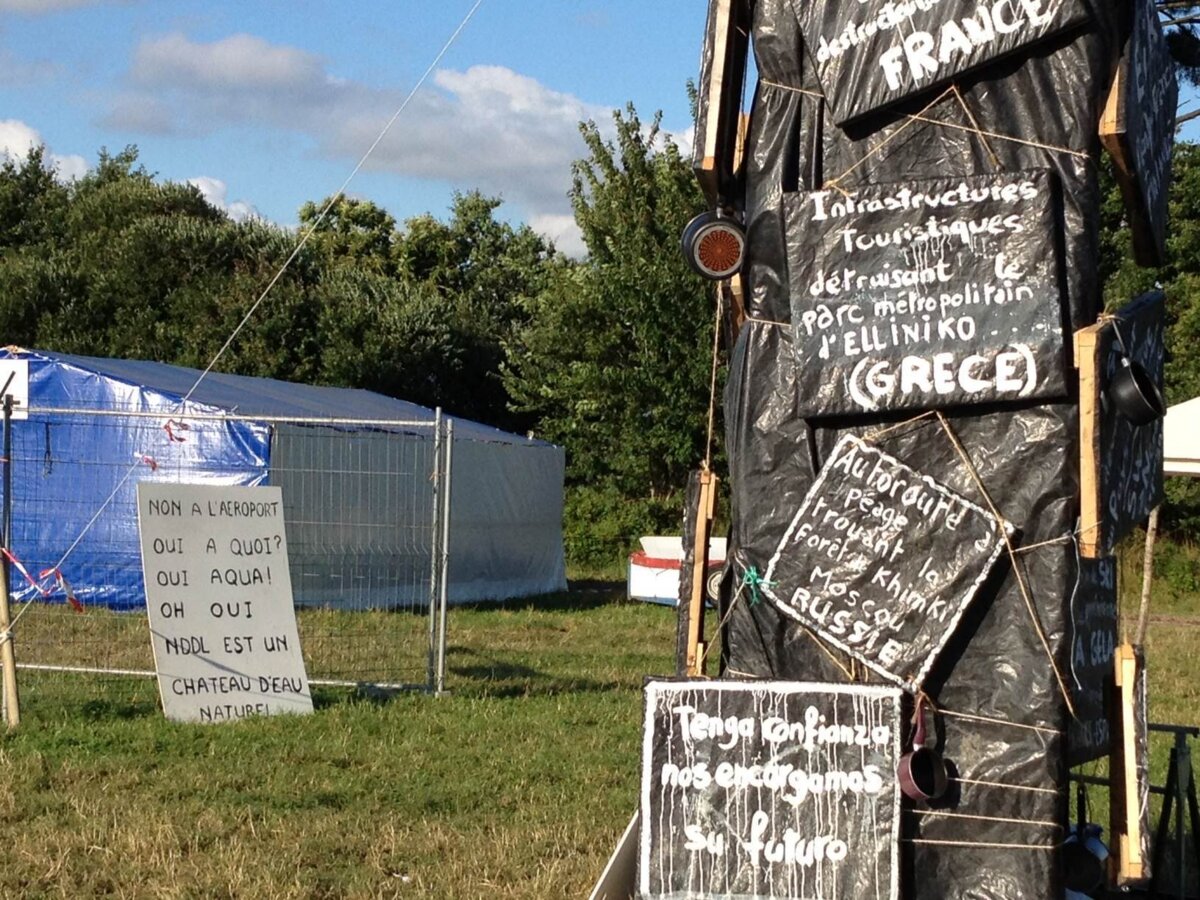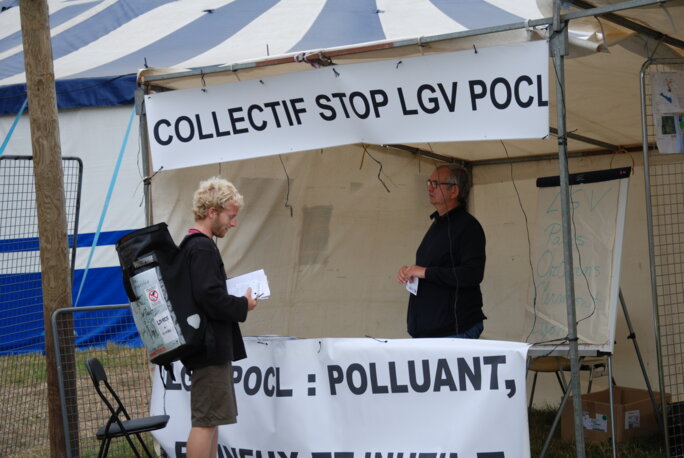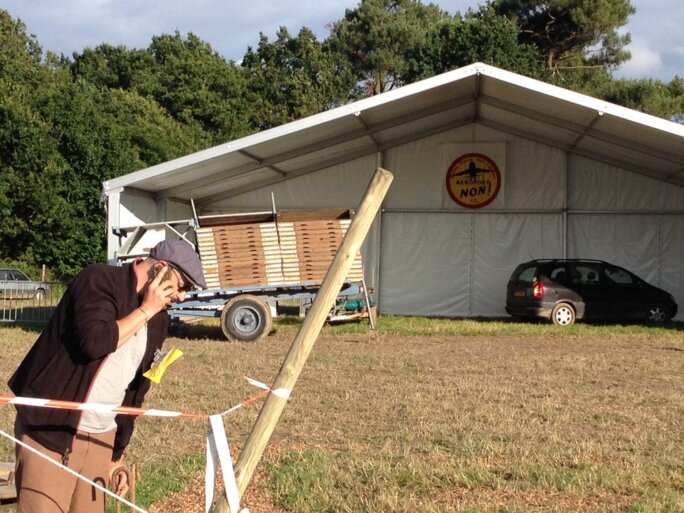From our special correspondent in Notre-Dame-des-Landes in the west of France
“4.30pm: a talk about a landfill project in Lapland.” Rising above the straw-floored multi-coloured tents, a female voice reels off the list of upcoming workshops on Tuesday, July 10th, the second-to-last day of this forum held last week against “unnecessary top-down large projects”. The list of white elephants in the sights of the forum ranges across Europe and beyond, encompassing Sheldon Adelson’s EuroVegas project in Spain, a high-speed rail line in Morocco, a brand new 60,000-seat stadium in Lyon in east central France called OL Land, a vast underground train station in Stuttgart in Germany called Stuttgart 21, and a huge property development scheme in Athens to repay some Greek debt, to name just a few.

Enlargement : Illustration 1

Yevgeniya Chirikova, the spearhead of Russian environmentalists’ opposition to the building of a motorway from Moscow to St Petersburg running right through Khimki Forest, tells kindred spirits in France about her struggle. Listening attentively are Dominique Fresneau, who is opposed to the building of a controversial new airport for Nantes in west France at Notre-Dame-des-Landes, and Bertille, who is occupying one of the hills around Lyon to say no to “OL Land”.
It just so happens that the three of them are up against the same foe: Vinci, the multinational French construction group behind all three mega-projects – proof that, although the geography of large-scale projects ranges far and wide, the industrial sector involved in their implementation is highly concentrated. The ears of Xavier Huillard, Vinci’s CEO, must have been burning more than once during this four-day forum. For a brief period, protesters calling themselves L’Armée des Clowns Agités du Bocage (perhaps the French counterpart of the Clandestine Insurgent Rebel Clown Army in the UK), even set up a mock tollbooth ('péage' in French) punningly dubbed the “Vinci pillage” on a road around Nantes.
Opposition movements to large-scale infrastructure projects, albeit often dismissed as NIMBYism (“Not In My Backyard”) activism, are nothing new. Eric Pétetin came to the forum to bear witness to this. Back in the 1990s he was one of the leading agitators against the Somport Tunnel road project in Aspe Valley in the French Pyrénées – for which he spent several months behind bars. “I had the feeling I was a small-scale protester: I lived in that valley. The road was going to run right in front of my house, we were all done for. But it was also an anti-capitalist movement to keep 'Babylon' out of our valley.” The political message did not go down well at the time, however, and much of the French left regarded this “mountain man” as, at best, a harmless lunatic.
‘Useful small-scale projects’
Twenty years down the road, protesting against big infrastructure projects has become a leitmotif of environmental activism. In 2011, it was the small Italian town of Venaus, in Susa Valley in the Piedmont, a pocket of resistance to the Lyon-Turin high-speed rail project, that hosted the very first forum on 'Opposing Unnecessary Large Projects'.
And this year it was the countryside on the outskirts of Nantes that hosted the meeting, on the initiative of the opponents of the Notre-Dame-des-Landes airport. The scale of the current recession and of public debt gives them new arguments against mega-projects, which can now be accused not only of making worse the problem of concreting over and gobbling up of green spaces, but also of increasing public debt, too.

Enlargement : Illustration 2

And NIABYs ("Not In Anyone’s Backyard") – as these protesters have described themselves since 2008 - are no longer the only ones to condemn the expense. The Cour des Comptes, the French audit office, recently expressed its concern over the colossal cost of the transport infrastructure projects launched during President Nicolas Sarkozy’s five years in office: 260 billion euros, a third of which is to be paid by the French government and 38% by the municipalities. Too expensive, say the state auditors, who are calling for a re-audit of plans to build 14 new LGV high-speed rail lines.
On the same day as that report's publication, July 11th, budget minister Jérôme Cahuzac announced that the government did indeed intend to cancel the construction of some of the new lines.
So does that mean the financial crisis is a boon to the environment? Well, it’s not that simple. Natassa Tsironi, from a grass-roots association fighting over the grounds of what was once Elleniko airport in Athens, explains how the site is to be developed into a complex of offices and homes – but also marinas – to help repay Greek debt: “They say they want to create a ‘new Monaco’,” though the grounds were initially supposed to be turned into a city park. “Since the outbreak of the crisis, things have got worse,” she insists.
Aurélie Trouvé, co-president of Attac, concurs: “Social austerity also means environmental austerity, too. In Greece they’re deregulating the environment as well.” Even if there are some “useful small-scale projects” in the face of these white elephants, “they need to serve as a lever to change society completely,” she urges, and should not be limited in ambition. Specifically, she says the rural conservation organisations the Associations pour le Maintien de l’Agriculture Paysanne (AMAPs) ought to set their sights on overhauling EU farming policy.

Enlargement : Illustration 3

The debates are concentrated, diverse and multilingual. But the tents they are held in are not full, and organisers are having a tough time mobilising the nation against “unnecessary top-down large projects”. Earlier in the week, only a few hundred people showed up. And the turnout for the big weekend rally only came to about 3,000, down from 5,000 the year before. “We need to create events to say that these big useless projects are not what we want for society,” explains an opponent of the Notre-Dame-des-Landes airport. “It’s good to spread the word, but we’re having a hard time motivating the communities around us who spend their time watching TV serials rather than getting involved in what’s going down in their own backyard.”
Faced with these difficulties, the activists are looking for new ways to muster support, for softer, more recreational approaches. The protest group the Filles et les Fils de Butte collective, for example, committed to stopping the construction of the OL Land stadium, have invited activists and anyone who is curious to spend a weekend at their little utopian spot in Lyon.
As for the opponents of the high-speed rail line between Lyon and Turin, the Comitato NO TAV are putting together a whole programme of holiday activism at campsites, at gîtes and, “even better”, at locals’ homes. “We’re neither violent nor extremists,” Claudio Giorno, co-founder of this now 20-year-old movement, says with a smile. The campaign is called Quindici Giorni per Respirare, or ‘A Fortnight of Fresh Air’ – which is a far cry from the usual caricature of hooded ‘black bloc’ protesters.
In fact, it almost sounds like a slogan from a rural tourist office.
-------------------------------
English version: Eric Rosencrantz
(Editing by Michael Streeter)


